On Feb. 3, 2023, a train carrying chemicals jumped the tracks in East Palestine, Ohio, rupturing railcars filled with hazardous materials and fueling chemical fires at the foothills of the Appalachian Mountains.
The disaster drew global attention as the governors of Ohio and Pennsylvania urged evacuations for a mile around the site. Flames and smoke billowed from burning chemicals, and an acrid odor radiated from the derailment area as chemicals entered the air and spilled into a nearby creek.
Three days later, at the urging of the rail company, Norfolk Southern, about 1 million pounds of vinyl chloride, a chemical that can be toxic to humans at high doses, was released from the damaged train cars and set aflame.
Federal investigators later concluded that the open burn and the black mushroom cloud it produced were unnecessary, but it was too late. Railcar chemicals spread into Ohio and Pennsylvania.
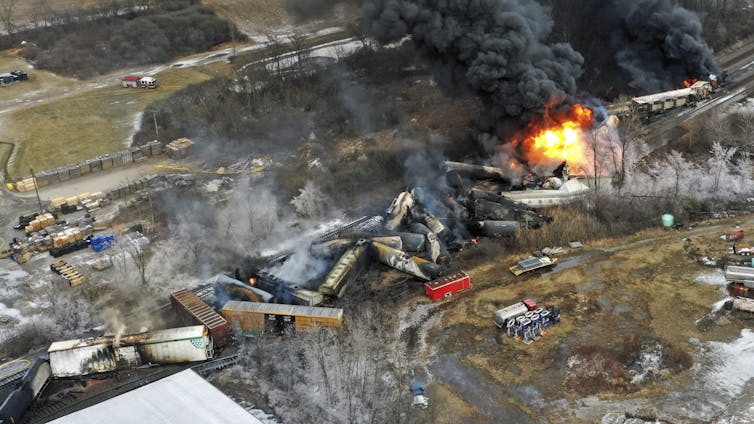
As an environmental engineers, I and my colleagues are often asked to assist with public health decisions after disasters by government agencies and communities. After the evacuation order was lifted, community members asked for help.
In a new study, we describe the contamination we found, along with problems with the response and cleanup that, in some cases, increased the chances that people would be exposed to hazardous chemicals. It offers important lessons to better protect communities in the future.
How chemicals get into homes and water
When large amounts of chemicals are released into the environment, the air can become toxic. Chemicals can also wash into waterways and seep into the ground, contaminating groundwater and wells. Some chemicals can travel below ground into nearby buildings and make the indoor air unsafe.
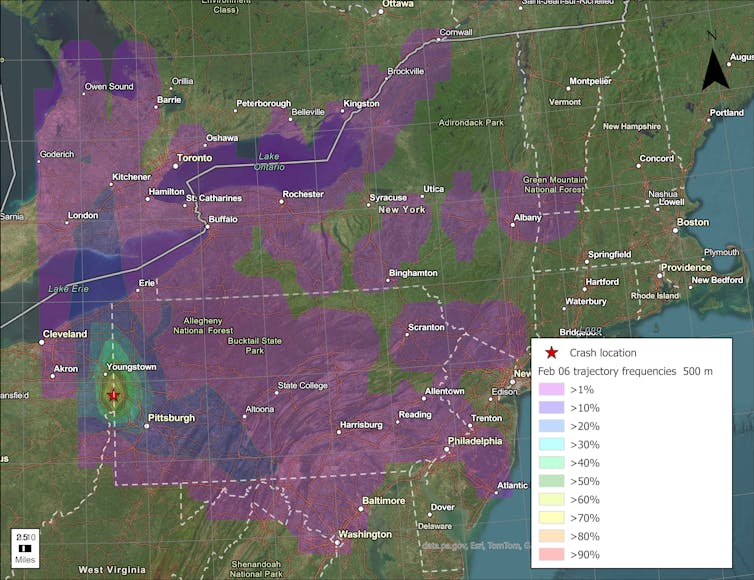
Air pollution can find its way into buildings through cracks, windows, doors and other portals. Once inside, the chemicals can penetrate home items like carpets, drapes, furniture, counters and clothing. When the air is stirred up, those chemicals can be released again.
Evacuation order lifted, but buildings were contaminated
Three weeks after the derailment, we began investigating the safety of the area near 17 buildings in Ohio and Pennsylvania. The highest concentration of air pollution occurred in the 1-mile evacuation zone and a shelter-in-place band another mile beyond that. But the chemical plume also traveled outside these areas.
In and outside East Palestine, evidence indicated that chemicals from the railcars had entered buildings. Many residents complained about headaches, rashes and other health symptoms after reentering the buildings.
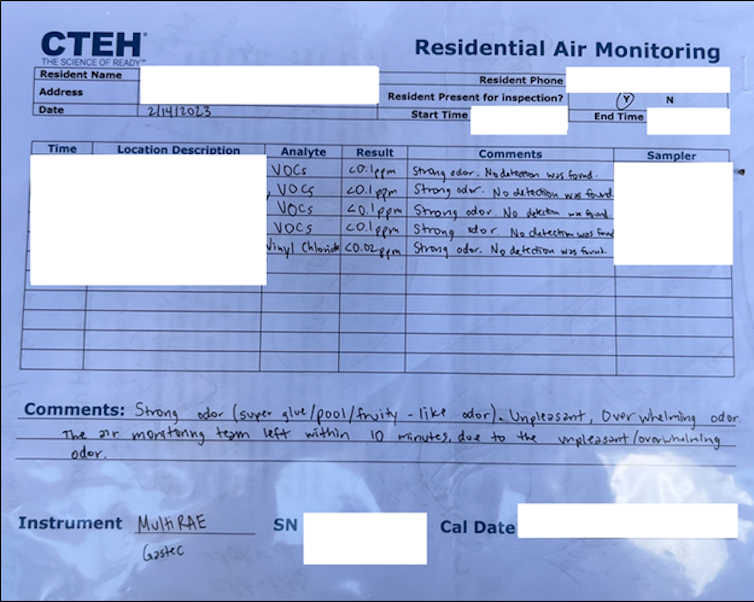
At one building 0.2 miles away from the derailment site, the indoor air was still contaminated more than four months later.
Nine days after the derailment, sophisticated air testing by a business owner showed the building’s indoor air was contaminated with butyl acrylate and other chemicals carried by the railcars. Butyl acrylate was found above the two-week exposure level, a level at which measures should be taken to protect human health.
When rail company contractors visited the building 11 days after the wreck, their team left after just 10 minutes. They reported an “overwhelming/unpleasent odor” even though their government-approved handheld air pollution detectors detected no chemicals. This building was located directly above Sulphur Run creek, which had been heavily contaminated by the spill. Chemicals likely entered from the initial smoke plumes and also rose from the creek into the building.
Our tests weeks later revealed that railcar chemicals had even penetrated the business’s silicone wristband products on its shelves. We also detected several other chemicals that may have been associated with the spill.
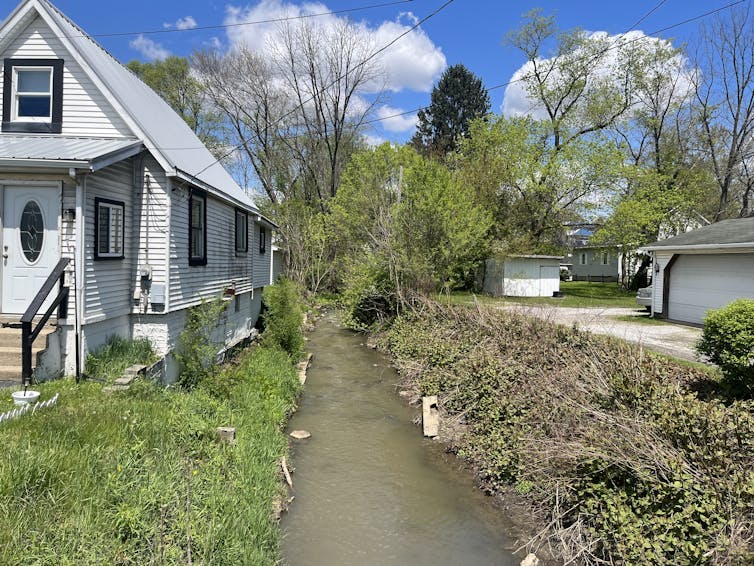
Weeks after the derailment, government officials discovered that air in the East Palestine Municipal Building, about 0.7 miles away from the derailment site, was also contaminated. Airborne chemicals had entered that building through an open drain pipe from Sulphur Run.
More than a month after the evacuation order was lifted, the Ohio Environmental Protection Agency acknowledged that multiple buildings in East Palestine were being contaminated as contractors cleaned contaminated culverts under and alongside buildings. Chemicals were entering the buildings.
Contaminated water can cause contaminated air
The creek that flowed through town became heavily contaminated by the spill. More than 43,000 fish died downstream, and chemicals traveled 270 miles (435 kilometers) down the Ohio River.
As tainted water flowed downstream, light chemicals like butyl acrylate naturally left the creek and entered the air by a process called volatilization.
Unnaturally however, the equipment used for cleaning the creeks also transferred chemicals from the water into the air. Residents near aeration equipment, which injects air into water, in part to help fish survive, complained of odors entering their homes and experiencing health problems. Our study shows the chemicals in the air may have been up to 2 to 25 times higher near these aerators.
Over the four-month study period, rain and the actions of contractors increasing and decreasing water flow also stirred up the creeks, releasing more chemicals into the air.
Steps to protect public health in future disasters
As with past disasters, what happened in East Palestine offers many lessons for communities.
One of the most important is for communities to demand an exposure pathway diagram immediately after a chemical incident occurs. An illustration can help the community recognize potential threats, whether from the air or from culverts beneath their buildings, and see where testing and guidance are needed.
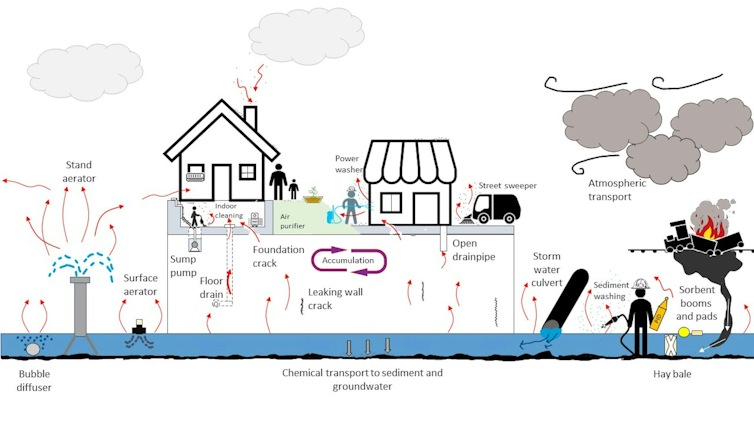
Monitoring the health of people exposed to the chemicals is also crucial. Because so many people became ill in and around East Palestine, and because testing overseen by government agencies did not pinpoint the exact conditions responsible for the illnesses, we recommend long-term medical monitoring for those affected.
People closest to the disaster site – those who lived in, worked in or visited buildings that became contaminated – likely experienced the greatest exposures. Railroad workers, government workers, cleanup workers, visitors and residents in Ohio and Pennsylvania were among those reporting health problems. Norfolk Southern and one contractor were cited for failing to protect workers from exposure.
Indoor building contamination can be a long-term problem. Just like with wildfire smoke, affected buildings need to be professionally cleaned because the chemicals can remain for months.
Building exteriors also need to be decontaminated. Chemicals may continue to release from surfaces into the air.
There is also a need for better methods and evidence-based policies to rapidly identify chemical exposures. The U.S. Environmental Protection Agency, months after approving the use of handheld air testing devices to screen homes, determined that those chemical detectors could not have reliably alerted to butyl acrylate at all levels that can cause health problems. Not all the chemicals spilled were monitored for in buildings.
For complex disasters, we recommend calling in experts from outside the responding agencies and companies involved to provide the needed specialized expertise.

 German (DE)
German (DE)  English (US)
English (US)  Spanish (ES)
Spanish (ES)  French (FR)
French (FR)  Hindi (IN)
Hindi (IN)  Italian (IT)
Italian (IT)  Russian (RU)
Russian (RU)  4 hours ago
4 hours ago

























Comments